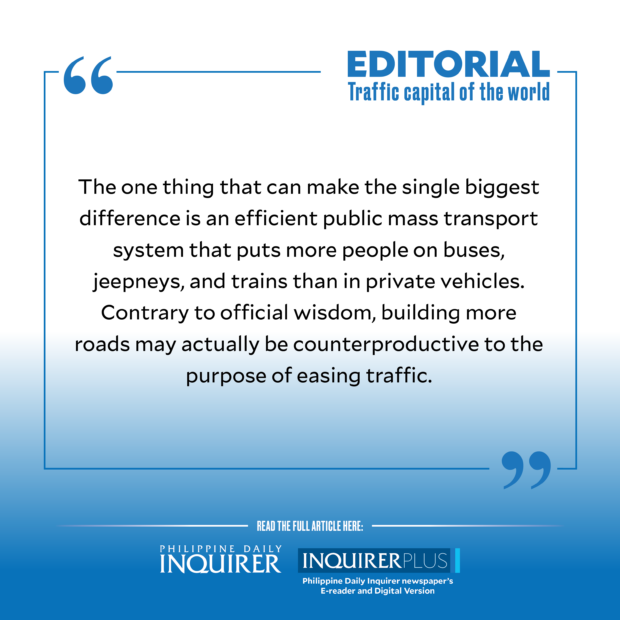
Coldplay’s lead vocalist Chris Martin didn’t mince words describing the traffic gridlock his entourage endured en route to the Philippine Arena in Bulacan for the group’s “Music of the Spheres” world tour on Friday. “We’ve seen some traffic. But I think you have the No. 1 in the world,” the British singer said.
He wasn’t joking. Metro Manila is now the undisputed traffic capital of the world, based on the latest study by TomTom, a Dutch navigation technology company.
Home to over 13 million people, the National Capital Region earned the dubious honor of having the worst traffic congestion among metropolises in 2023, according to the study that covered 387 cities and 55 countries. It was followed by Lima, Peru; Bengaluru, India; Sapporo, Japan; and Bogota, Colombia.
The latest index has two categories: city center and metro area, with Metro Manila listed as No. 1 in the latter and Manila as No. 9 in the former.
Five days stuck on the road
On average, the 2023 study found that Metro Manila motorists spent 25 minutes and 30 seconds covering a distance of 10 kilometers last year. In terms of time lost to heavy traffic, they suffered 117 hours — or almost five days — stuck on the road in 2023, the study found.
This is not the first time for such shameful distinction. In September 2019, traffic navigation app Waze found Metro Manila to be the worst city in the world to drive in, taking 4.9 minutes to reach a full kilometer.
“With more than half of the world’s population living in urban areas, traffic congestion and its economic, ecological and health consequences have become a problem that needs to be urgently addressed,” said Ralf-Peter Schäfer, TomTom’s vice president for traffic.
“Planning the future of urban areas is essential to ongoing traffic management,” he added.
But there’s the rub—is there such a plan in the Philippines?
P2.4 billion daily loss
In response to the TomTom index, Transportation Secretary Jaime Bautista said road projects in progress would soon “improve the commuter experience.”
In September, President Marcos said on his vlog: “We will do everything [to address traffic problems], which is why we are acquiring new trains and building new roads so that traffic will ease and you will not have to suffer.”
Yet, four months later, the misery on metro roads has only grown, one from which Mr. Marcos himself has been spared by the mere privilege of his office.
On Friday, the President was among the scores who watched Coldplay’s concert, but unlike them, he arrived and left via presidential chopper.
A 2014 study by the Japanese International Cooperation Agency estimated that Metro Manila’s traffic crisis was costing the economy P2.4 billion daily in terms of vehicular maintenance expenses and time lost. If left unaddressed, it said, losses could climb to a staggering P6 billion a day by 2030.
Urban living nightmare
Beyond productivity costs, there’s the psychological toll on Filipinos’ well-being, adding to the ills that make urban living a nightmare, such as rocketing prices, rising criminality, and noise and environmental pollution.
The government, through the Department of Transportation, its attached agencies and the Metropolitan Manila Development Authority, must make traffic management a top priority.
For a start, traffic policies must be made seamless among local governments within the metro, and the single-ticketing system enforced fully. All construction work must be scheduled with public convenience in mind. Any act of favoritism toward VIPs should be punished.
Illegally parked cars should be towed and their owners fined, and Congress must pass a law banning the purchase of new cars without a parking space.
The government must instill discipline among drivers on the road.
We often hear complaints about Filipinos following traffic rules abroad but forgetting to do so upon their return. Such lack of discipline is learned behavior that is the result of decades of traffic mismanagement. The government must ensure a strict, no-nonsense traffic enforcement to compel motorists to unlearn their bad road habits.
Braess paradox
Finally, the one thing that can make the single biggest difference is an efficient public mass transport system that puts more people on buses, jeepneys, and trains than in private vehicles.
Contrary to official wisdom, building more roads may actually be counterproductive to the purpose of easing traffic. Our urban planners will do well to read up on the Braess paradox, a mathematical phenomenon that explains how and why constructing more highways can ironically result in more traffic jams. Just look at the transport systems and infrastructures of Singapore, Tokyo, and Hong Kong.
For Metro Manila and other urban centers to be truly livable, the best policy is to bring about the greatest good for the greatest number — being less “car-centric” and more friendly to commuters, cyclists, and pedestrians.

